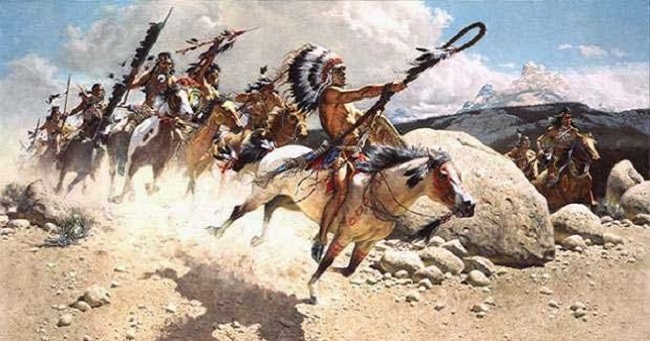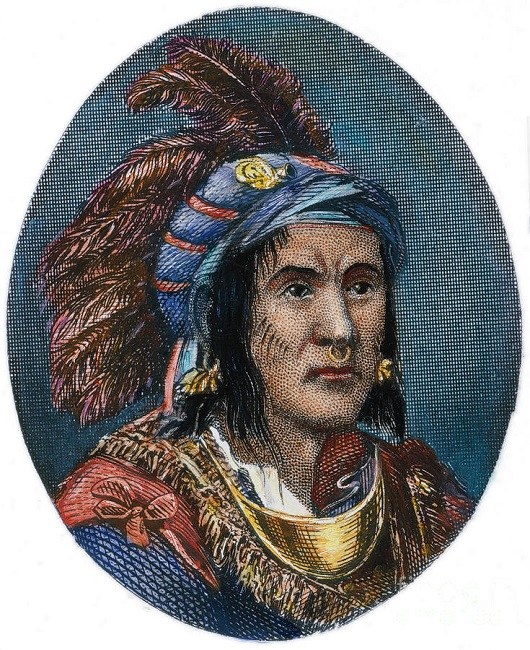


The presence of white settlers in America meant ensuing feuds with Native Americans (Indians) was apparent. Despite peaceful meetings and treaties, there were several skirmishes and massacres resulting in the settlers overcoming the natives due to the superiority of weapons, organization, and resources. The United States government offered treaties that sought to relocate Indians onto reservations guaranteeing them land in the west. These were constantly breached by the U.S. government but were nonetheless signed by several tribes. There were certain fierce tribes opposed to such agreements preferring to fight the government. Some of them were led by equally fierce Native American Chiefs whose names are now famous for having led their tribes into some of the bloodiest battles in US- Indian history. Here are ten of them.
Pontiac was a well-known warrior in the French and Indian Wars. He was chief of his tribe in Ottawa and had entered into an alliance with New France against the British colonists. Still the British were victorious in the war. Pontiac later launched a rebellion against the British after becoming upset with the new trading policies. He attracted several regional tribes to his cause to form a resistance against the British, thus starting Pontiac’s Rebellion/War. It began in 1763 when Pontiac attacked a fort in Detroit.
The attack was unsuccessful but various other forts were destroyed throughout Michigan and Western Pennsylvania causing heavy casualties for the British. 3 years later Pontiac signed a treaty with the British for his own amnesty which sparked anger amongst many Indians. In 1769 he was killed by a member of a different tribe.

Image Source: www.fineartamerica.com
Little Crow was born around 1810 into the Mdewakanton Dakota Sioux tribe. He out-dueled his brother claiming top position and became the tribe’s chief. In a war bearing his name- Little Crow’s War, commonly known the Dakota War of 1862, he clashed several times with the U.S. forces. Little crow began attacking settlers in southern Minnesota after becoming upset with the U.S. not honoring the treaties. These attacks continued until his defeat that had him flee to Canada. In 1863 he was shot dead by a settler in Minnesota.
Image Source: www.usdakotawar.org
In the Midwest, a war chief of the Sauk tribe named Black Hawk earned a fearsome reputation after scalping his first Indian as a young teen and conducting numerous raids on other tribes in his adult years. Although he clashed with American forces in the War of 1812, he later signed a treaty with them. However, in 1832, in an attempt to resettle on his tribe’s ancestral homeland that had been ceded by the treaty to the U.S, a violent dispute broke out. This alarmed the white settlers in the region who sent out militiamen to confront Black Hawk. His warriors easily defeated the militia group and ended up starting the Black Hawk War. The U.S. was victorious forcing Black Hawk and his followers to flee to Wisconsin. There he fought several battles until he finally surrendered. In 1838, Black died in his village in Iowa, aged 71.
Image Source: www.britannica.com
Upon becoming the chief of the Shawnee tribe in 1808, Tecumseh, with the help of his younger brother Tenskwatawa successfully built an Indian confederation in Ohio. Tecumseh was against the signing of unfair peace treaties by other tribes and urged them to stop doing so. In 1810, he led several hundred men and confronted Territory Governor General William Henry Harrison at his home in Indiana. But, the intervention of U.S. soldiers drove Tecumseh and his men away. The following year, Governor General Harrison and his troops routed Tecumseh and his followers in the Battle of Tippecanoe at Alabama. In the War of 1812 Tecumseh allied with the British. He played an active part in many battles including the capture of Detroit. In 1813 he was eventually killed in battle in Ontario, Canada.
Image Source: www.wikimedia.org
Like Crazy Horse, Red Cloud was also a chief of the Oglala Lakota Indians and fought the “Red Cloud’s War” between 1866 & 1868. Enraged at the U.S. for planning to build the Bozeman Trail through Indian Territory, a war party was organized and dispatched under Red Cloud to confront the U.S. The party consisted of several thousands of Lakota, Arapaho and Cheyenne Indians who attacked travelers and forts. The infamous ‘Fetterman Massacre’ was another incident in which 3,000 Indians killed and mutilated 80 U.S. troops in the area. This caused the U.S. government to abandon the plans for the trail and withdraw from the area. Red Cloud signed a treaty in 1868 with the U.S. This made him lose some standing in his tribe and more so when the treaty’s terms were broken. He died in the South Dakota Reservation in 1909 but is remembered as the lone Indian chief who won against the U.S. military.
Image Source: www.ytimg.com
Opechancanough earned a reputation of being a fierce warrior that gained him the status of chief of the Powhatan Confederacy. The Powhatan’s anger towards white settlers in Virginia led him to carry out two terrifying massacres on them. The first was in 1622 where the Powhatans attacked and massacred 350 settlers including men, women, and children. A ten-year war ensued thereafter between the Powhatan Indians and the white settlers of the U.S. In 1632 Opechancanough signed a treaty ending the hostilities. However, in 1644, despite being over 90 years old, he devised an attack that resulted in 500 casualties on the side of the settlers. Opechacanough was subsequently captured as a prisoner but shot dead some years later by a soldier.
Image Source: www.netdna-cdn.com
Sitting Bull came to be known as a thorn in the U.S. Army when he and his followers constantly raided U.S. Forts along the Missouri River. He was a war chief and spiritual leader of the Hunkpapa Sioux. He played an active role in the defeat of Lt. Col. George Custer and his troops in the “Battle of Little Big Horn”. While he never exactly took part in the action, he recruited thousands of Indians to the Sioux cause which was crucial for the battle. After the US increased anti-Indian efforts in the region, He fled to Canada accompanied by a few hundred of his followers. Sitting Bull surrendered in 1881 and was imprisoned for the next few years. In 1980 He was finally shot dead by the reservation police after a dispute in the Standing Rock Agency of South Dakota.
Image Source: www.wikimedia.org
Cochise was a Chiricahua Apache tribe chieftain who earned the nickname- ‘‘The Apache Napoleon”. He was on friendly terms with the white settlers but was falsely accused of kidnapping and as a result witnessed his relatives’ execution in 1861. Thereafter he considered it his mission to kill all white settlers in Arizona. Fighting relentlessly against both American and Mexican armies for years, he eventually engaged the U.S. Army at the battle of Apache Pass. This resulted in his defeat, but he continued attacking travelers and settlements on both sides of the U.S./Mexican border. Finally he signed a peace treaty with the U.S. in 1872 and died a few years later on a reservation.
Image Source: www.wetherillfamily.com
Crazy Horse was an Oglala Lakota chieftain renowned as a fierce warrior owing to his skirmishes with Plain Indian Tribes during the 1850s-1860s. He was involved in the planning, ambush and massacre of 80 U.S. soldiers stationed at Fort Kearney in Wyoming. Most famous of his roles was in the 1876 battle of southern Montana, where he led 1000 warriors against U.S. troops halting their advance as they attempted to march to another great battle, “the Battle of Little Big Horn. This resulted in an Indian victory where the famous Lt. Col. George Custer and some 267 soldiers were killed in action. In 1877, he was forced to surrender and 4 months later got killed in an argument with a soldier at the Red Cloud Agency in Nebraska.
Image Source: www.peoples.ru
Among the fiercest Native American chiefs, Geronimo is a legend. Geronimo was mainly driven by his hunger for revenge against the murder of his wife, mother and 3 children by Mexican soldiers who raided his settlement. He was an Apache warrior renowned for his guerilla tactics and was also suspected to have supernatural powers that safeguarded him in battles. He conducted raids between 1858-1886 against Mexicans and Americans in New Mexico, Western Texas and Arizona. In 1886, Geronimo finally surrendered and came to be known by the public as the “wickedest Indian who ever lived”. He died from pneumonia in 1909. Upon his deathbed his final words to a relative were- “I should never have surrendered. I should have fought until I was the last man alive”.
Image Source: www.biography.com